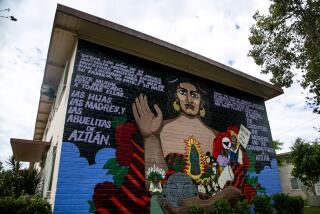Publishers of El Latino Are Winning at a ‘Big Boys’ Game : Media: San Diego sisters pride themselves on the objectivity of the Spanish-language weekly they run.
- Share via
If you ask El Latino Publisher Carmen Miller, 26, how she competes with other newspapers for San Diego County’s coveted Spanish readers, she’ll tell you:
“We play the game like the big boys play it.”
For Carmen and her co-publisher and 25-year-old sister, Fanny, playing it like the big boys means printing a 4-year-old tabloid that each week attracts 20,000 readers.
To gain that kind of readership, Carmen acts not only as co-publisher, but also as the head of marketing, advertising director and editor in chief. She is also the single mother of three children.
The paper, with offices in the shadow of the San Diego Sports Arena, has seven reporters in a 1,200-square-foot suite.
According to its readers, the free, all-Spanish paper fills a niche by providing informative, local news to the Spanish-speaking community.
“The paper has a pretty wide circulation--I see it everywhere. It’s something we really need (since) we have a growing Mexican, Latino population,” said Roberto Martinez, director of the American Friends Service Committee, a human rights and immigration advocacy group in San Diego.
The little tabloid--one of only a few in the county catering to the Spanish-reading public--provides “a spiritual fulfillment” for its readers since it helps them “remember their roots,” said Arturo Urgelles, owner of The Art-Te Company, an all-Spanish record and video store in downtown San Diego.
One of the things that makes El Latino different are the Miller sisters, who had no publishing experience before this venture. What they have is a strong belief in local news that serves the Latino population. It is a key reason, they say, for the paper’s popularity.
“We are writing about San Diego for the Latinos in San Diego,” Carmen said.
“It’s informative and it’s local. . . . Other papers have more national and international news, but El Latino provides the local coverage,” Martinez said.
Carmen believes that El Latino’s objective approach to news stories has also endeared the paper to readers.
“In other Hispanic community so-called ‘newspapers,’ the reporters speak their minds and make it seem like news. We give both parts of an issue and let them make up their own mind,” Carmen said. “That is the biggest difference between us and every other Hispanic paper in town.”
Other papers “kind of bash everything they do not like,” she said. “Hispanic people, like every other reader in the world, don’t like that.”
Despite a weak economy that has U.S. newspapers big and small struggling, El Latino has continued to flourish.
“About 60% to 70% of our advertisers have been with us for two years,” Fanny said. Not surprisingly, that period coincides with the date the sisters took control of the paper.
“From the business side--ad sales and things like that--they have jumped off to a very good start,” said Kirk Whisler of Las Vegas, a founder of the National Assn. of Hispanic Publications.
Whisler said El Latino won the “Most Improved Publication” award for smaller papers at his organization’s convention in February.
Whisler also noted that the paper’s switch last June from biweekly to weekly was a positive sign.
On top of that, the paper has plans to expand next month to a larger edition, Carmen said.
“We average 24 pages per week now; in May, we will be at least 40 pages,” she said.
Also in May, El Latino will begin charging readers for the paper, which has been free since its first edition in May, 1988, the publishers said. Fanny said the price of the newspaper will be less than a dollar.
The sisters, 13-year residents of San Diego, say they are not afraid of converting to the pay-per-paper basis since they ran a questionnaire asking readers whether they would buy El Latino.
“Ninety-nine point five said, ‘Yes, we would buy it if it was not free,’ ” Carmen said.
The Colombian-born sisters came to San Diego when they were adopted by their aunt in 1979, Fanny said.
At the time, Carmen was 12 and Fanny 11. The two didn’t speak a word of English, but by working in their adopted father’s 7-Eleven in Oceanside, they learned the language quickly.
Though they became fluent in English, the sisters still wanted to read in their native tongue. When the opportunity to join with four other partners in the El Latino venture came in 1988, they jumped at the chance.
“Growing up in Carlsbad, we knew there was a need for something in Spanish,” Fanny said. “It was something we always looked for and could never find.”
El Latino can be found at drop-off points ranging from grocery stores to libraries to Mexican restaurants.
“We try to find the Hispanic (area) in each city, and keep dropping the papers there,” Fanny said.
The paper has a diverse audience, with different readers in different parts of the county, she said. In south San Diego, most of the readers are Latinos who have lived there “for years and years,” Fanny said.
North County has as many Anglos as Latinos reading El Latino, Fanny said. The personals section has “American men responding while the women are mostly Mexican.”
Overall, however, the sisters said the paper is designed specifically for the new migrant Latinos. The pair hopes to expand into Tijuana by the end of the year.
“There are quite a bit of readers in Tijuana (who) want to know what’s going on over here,” said Ron Luis Valles, editor in chief of The Forum, a business-oriented bilingual paper in San Diego.
The Millers have another goal for 1992: starting a monthly English paper focusing on Latino business and politics. They hope to launch the new effort in late fall.
With deadlines to meet, advertisers to please and readers to satisfy, publishing can be difficult. But Carmen and Fanny, once two little girls who wanted something to read in Spanish, see no end to their expansion.
“Our long-term goal is to build a chain of Hispanic newspapers in the Southwest,” Carmen said. “San Diego is a prototype of what things will be like.”
More to Read
Sign up for Essential California
The most important California stories and recommendations in your inbox every morning.
You may occasionally receive promotional content from the Los Angeles Times.










